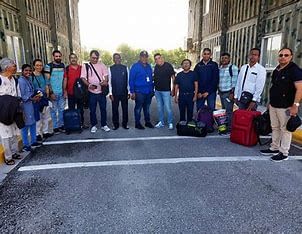UPSC Daily Current Affairs- 25th January 2024 | Current Affairs & Hindu Analysis: Daily, Weekly & Monthly PDF Download
GS-I
Teesta River
Subject: Geography

Why in News?
The tourism department of the Gorkhaland Territorial Administration (GTA) resumed rafting in the Teesta River recently after a gap of five months.
About Teesta River:
- It is a trans-Himalayan River flowing through the Indian states of Sikkim and West Bengal and, Rangpur in Bangladesh. It is a tributary of the Brahmaputra River.
- Origin: It originates in the Himalayas and flows through the Indian States of Sikkim and West Bengal before entering Bangladesh, where it flows into the Brahmaputra.
- It has a total length of about 309 kilometers. The flow of the Teesta is greatest during the summer (June to September), when the monsoon rains are heaviest and glaciers supply abundant meltwater.
- Main Tributary: Rangeet River
What is a Monsoon?
- Definition of Monsoon: A monsoon signifies a significant shift in wind patterns, typically leading to either intense rainfall or prolonged dry spells.
- Causes of Monsoon:
- Monsoons occur due to a seasonal alteration in wind directions, prompted by variations in land and water temperatures.
- Specifically, during seasonal transitions, such as the onset of summer, the land heats up more rapidly than bodies of water.
- Wind Direction: Monsoon winds invariably blow from colder regions towards warmer areas.
- Summer Dynamics: As summer progresses, the warming of land surfaces generates rising warm air, triggering a reversal in wind directions.
- Geographical Range: While commonly associated with parts of Asia, monsoons can manifest across numerous tropical and subtropical regions.
Source: Telegraph India
GIBRALTAR ARC
Subject: Geography

Why in News?
A modelling study suggests that a dormant subduction zone beneath the Gibraltar Strait (Gibraltar Arc) could become active and migrate into the Atlantic Ocean, potentially forming an Atlantic “Ring of Fire” in about 20 million years.
Background: The Gibraltar arc’s potential awakening could significantly impact the configuration of the Atlantic Ocean over millions of years.
About GIBRALTAR ARC:
- Geological Feature:
- The Gibraltar Arc, or Gibraltar Subduction Zone, is a significant geological structure situated beneath the Gibraltar Strait.
- Strait of Gibraltar:
- This strait is a narrow passage connecting the Atlantic Ocean with the Mediterranean Sea.
- It acts as a natural divider between Europe and Africa.
- Tectonic Plate Interaction:
- The Gibraltar region serves as the convergence point of two tectonic plates: the Eurasian Plate and the African Plate.
- Currently, the African Plate is subducting beneath the Eurasian Plate in this area.
- Subduction Process:
- Subduction refers to the movement of one tectonic plate beneath another, leading to seismic activity, volcanic eruptions, and the formation of mountain ranges.
- Dynamic Forces at Play:
- The Gibraltar Arc is a dynamic boundary where these immense geological forces sculpt the Earth’s crust.
- Other Subduction Zones:
- In the Atlantic region, notable subduction zones include the Lesser Antilles Arc in the Caribbean and the Scotia Arc near Antarctica.
Source: Live Science
E V Ramaswamy Naicker or Periyar
Subject: History

Why in News?
Tamil Nadu Chief Minister M K Stalin has voiced his backing for Carnatic vocalist T M Krishna in the midst of a debate surrounding the conferral of the Sangita Kalanidhi title by the Music Academy, Madras. The matter has attracted political and societal interest, particularly regarding critiques of the social reformer Periyar.
Background:-
- Over the years, Periyar has transcended the political divide as well as the faultlines of religion and caste, and come to be revered as Thanthai Periyar, the father figure of modern Tamil Nadu.
About Periyar
- Background:
- Periyar, born in 1879, is renowned for initiating the Self Respect Movement, aimed at attaining social equality for those marginalized by the caste system.
- Early Political Career:
- Initially affiliated with the Congress, Periyar clashed with Gandhi over the issue of separate dining arrangements for Brahmin and non-Brahmin students at a Congress-sponsored school.
- Gandhi suggested a compromise, but Periyar's opposition led to his resignation from the Congress in 1925.
- Association with Justice Party and Self Respect Movement:
- Periyar aligned himself with the Justice Party and spearheaded the Self Respect Movement, which opposed Brahmin dominance in social and bureaucratic spheres.
- The movement advocated for weddings without rituals, property rights for women, and inter-dining to challenge caste distinctions.
- Significance Beyond Tamil Region:
- Periyar gained prominence during the Vaikom Satyagraha of 1924, advocating for the rights of lower-caste individuals to access public paths near temples.
- His involvement earned him the moniker "Vaikom Veerar" (Hero of Vaikom).
- Dravidian Movement:
- Periyar redefined Tamil identity as inherently egalitarian and argued that the caste system was introduced to the region from elsewhere.
- He transformed the Dravidian Movement into a campaign against caste discrimination and a reaffirmation of Tamil national identity.
- Establishment of Dravidar Kazhagam:
- In the 1940s, Periyar founded the Dravidar Kazhagam, advocating for an independent Dravida Nadu comprising Tamil, Malayalam, Telugu, and Kannada speakers.
- Legacy:
- Periyar is revered as an ideology representing social equality, self-respect, and linguistic pride.
- His reformist agenda challenged societal norms regarding faith, gender, and tradition, urging people to adopt rationality in their choices.
Source: Indian Express
GS-II
Preventive Detention
Subject: Polity and Governance

Why in News?
Observing that preventive detention is a draconian measure and any such move based on a capricious or routine exercise of powers must be nipped in the bud, the Supreme Court has set aside a Telangana High Court order rejecting a detenu’s appeal.
About Preventive Detention:
- Definition of Preventive Detention:
- Preventive detention involves holding an individual in custody without a trial or conviction by a court. Its primary aim is not punitive but rather to prevent the individual from committing future offenses.
- Purpose of Preventive Detention Laws:
- Governments enact preventive detention laws to ensure public safety and uphold social order.
- Constitutional Provisions and Safeguards:
- Article 22 of the Indian Constitution safeguards individuals who are arrested or detained.
- It consists of two parts:
- The first part addresses ordinary law cases, where detention occurs as part of a criminal investigation.
- The second part pertains to preventive detention law, which involves detaining individuals without trial or conviction.
- Article 22(4) stipulates that no law for preventive detention shall permit detention beyond three months unless an Advisory Board provides adequate justification for prolonged detention.
- The detainee has the right to be informed of the grounds for their detention. However, the state may withhold this information if it is deemed in the public interest.
- Authorities detaining an individual must offer them the earliest opportunity to present their case against the detention.
Who can make laws under Preventive Detention?
- Parliament has the exclusive power to enact a law for preventive detention for reasons connected with defence, foreign affairs, or security of India.
- Both Parliament and State Legislature have powers to enact a law for preventive detention for reasons related to the maintenance of public order or the maintenance of supplies or services essential to the community.
- Laws that provide for Preventive Detention:
- In India, various laws provide for preventive detention, including the National Security Act (NSA) of 1980, the Unlawful Activities (Prevention) Act (UAPA) of 1967, and state-specific laws like the Maintenance of Internal Security Act (MISA) and the Public Safety Acts (PSA) in certain states.
- Under these laws, authorities can detain an individual for a specific period, typically up to 12 months, without presenting formal charges or conducting a trial.
- The detention order is issued by a designated authority or government official and is subject to periodic review by an advisory board.
Source: Indian Express
Bilateral Investment Treaties (BITs)
Subject: International Relations

Why in News?
India is negotiating BITs with trade partners to boost the inflow of foreign direct investments (FDI).
Background:
- Before 2015, India had BITs with 83 countries or regions but India suspended BITs with 68 countries/regions with a request to re-negotiate based on the model 2016 BIT. Six BITs are still in force. The suspension was triggered by several high profile defeats in investor-state disputes.
About Bilateral Investment Treaties (BITs):
- They are reciprocal agreements between two countries to promote and protect foreign private investments in each other’s territories.
- India had signed BITs with 83 countries of which 74 were in force till 2015.
- India revised its Model BIT in 2016. Since 2015, India has signed new BITs only with four countries is negotiating with 37 countries, and terminated its older BITs with 77 countries.
Key features of Model BIT 2016:
- “Enterprise” based definition of investment means an enterprise that has been constituted, organised, and operated in good faith by an investor in accordance with the domestic laws of the country.
- Non-discriminatory treatment through due process as each party shall accord full protection and security to the investments and investors.
- National treatment and protections against expropriation as neither party may nationalize or expropriate an investment of an investor directly or through measures having an effect equivalent to expropriation.
- A foreign investor should first exhaust local remedies at least for a period of five years before going for the Investor-State Dispute Settlement (ISDS) mechanism.
Existing issues/concerns with Model BIT:
- Experts suggest that India brought in Model BIT 2016 in reaction to a series of notices that India received. It has too many exceptions which limit the liability of the host state and raise the bar required to bring a claim under the BIT.
- The Arbitration Mechanism is considered to be the most contentious issue which insists on the investor exhausting the domestic remedies for at least five years before commencing arbitration under the BIT.
- Enterprise-based definition of investment narrows down the definition of investment. Moreover, it is considered to have vague qualifications such as “certain duration” and “significance for the development of the party in whose territory the investment is made.”
- Omission of “fair and equitable treatment” standard. It has been replaced with protections that require steep thresholds to be triggered and/or invoked. Moreover, the doctrines of Most-Favoured Nation and “legitimate expectation” are also absent.
- Exemption of taxation measures from the protections offered under BIT seems to be a restatement of sovereignty rather than a treaty meant to protect cross-border commercial transactions.
- Lack of professionals as India does not have a sufficient number of lawyers/judges with the requisite expertise and experience. Thus, huge fees are paid to foreign law firms that represent India in investment arbitration.
Source: Indian Express
GS-III
OPERATION INDRAVATI
Subject: Defence and Security
Why in News?
India has recently launched ‘Operation Indravati’.
Background:
- India’s Operation Indravati is a commendable effort to ensure the safety and well-being of its citizens in the midst of the crisis in Haiti.
About OPERATION INDRAVATI:
- Operation Indravati is an initiative launched by India to evacuate its citizens from Haiti amidst the country’s turmoil.
- The operation is named after the Indravati River in India.
- The aim of this operation is to transfer Indians to the neighbouring Dominican Republic due to escalating violence and chaos in Haiti.
Haiti
- Location and Background:
- Haiti is situated in the Caribbean and shares the island of Hispaniola with the Dominican Republic.
- The country has faced persistent challenges, including gang violence and political instability.
- Trigger Event:
- The crisis escalated after the assassination of President Jovenel Moise in July 2021, leaving a power vacuum in the country.
- Political Transition:
- Prime Minister Ariel Henry assumed power following Moise's assassination and garnered support from several nations.
- However, efforts to establish a stable political transition have faltered.
- Escalation of Violence:
- Various armed groups have launched coordinated attacks on critical installations, aiming to pressure Henry into resigning.
- Current Situation:
- Haiti continues to grapple with the aftermath of Moise's assassination, with ongoing gang violence and political turmoil exacerbating the situation.
Source: The Hindu
GLOBAL E-WASTE MONITOR (GEM) 2024 REPORT
Subject: Environment and Ecology

Why in News?
The Fourth Global E-waste Monitor (GEM) 2024 was recently released.
Background:
- The report providing crucial insights into the global electronic waste crisis.
About E- Waste:
- E-waste, short for Electronic Waste, refers to old, end-of-life, or discarded electronic appliances.
- It encompasses a wide range of electrical and electronic devices, including their components, consumables, parts, and spares. E-waste poses environmental and health risks if not appropriately treated, disposed of, and recycled.
- The 2024 Global E-waste Monitor (GEM) was prepared by the UN’s International Telecommunication Union (ITU) and the UN Institute for Training and Research (UNITAR).
Key Highlights of the Global E-waste Monitor 2024
E-waste Generation Trends:
- Between 2010 and 2022, global e-waste generation surged from 34 billion kilograms to 62 billion kilograms.
- This upward trend is expected to continue, reaching an estimated 82 billion kilograms by 2030.
- Unfortunately, only 13.8 billion kilograms of this e-waste were formally collected and recycled in an environmentally sound manner.
Factors contribute to the increase in e-waste
- Technological Progress: Rapid advancements lead to shorter product lifecycles.
- Higher Consumption Rates: Our reliance on electronic devices continues to grow.
- Limited Repair Options: Many devices are designed for obsolescence.
- Growing Electronification: More aspects of our lives become digital.
- Inadequate E-waste Management Infrastructure: Insufficient systems for proper disposal and recycling.
Informal Recycling Sector:
- The informal sector handles a significant portion of e-waste globally.
- This holds true for both high- and upper-middle-income countries as well as low- and lower-middle-income countries.
- The lack of formal e-waste management infrastructure drives reliance on informal channels.
Regional Disparities:
- Europe leads in documented formal collection and recycling of e-waste, with a rate of 42.8%.
- In contrast, Africa faces challenges, with a recycling rate of less than 1%, despite generating lower amounts of e-waste.
- Asia, including India, generates a significant portion of global e-waste but has made limited advances in e-waste management.
- Countries in Asia generate almost half of the world’s e-waste (30 bn kg) but relatively few of them have enacted legislation or established clear e-waste collection targets.
Policy Adoption:
- 81 countries have adopted e-waste policy, legislation or regulation.
- Sixty-seven countries have legal provisions on Extended Producer Responsibility (EPR) for e-waste.
- Another 46 have provisions on e-waste collection rate targets. Finally, 36 countries have provisions on e-waste recycling rate targets.
Source: Business Standard
|
38 videos|5293 docs|1118 tests
|
FAQs on UPSC Daily Current Affairs- 25th January 2024 - Current Affairs & Hindu Analysis: Daily, Weekly & Monthly
| 1. What is the significance of the Teesta River in India? |  |
| 2. What is the Gibraltar Arc and why is it important? |  |
| 3. Who was E V Ramaswamy Naicker, also known as Periyar, and what was his contribution to Indian society? |  |
| 4. What is Preventive Detention and how does it impact civil liberties? |  |
| 5. What is the significance of Bilateral Investment Treaties (BITs) in international trade and investment? |  |
















